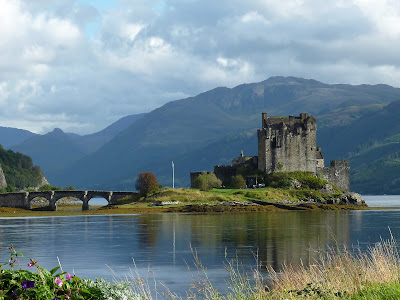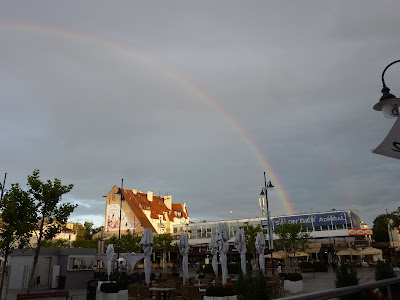We started the day off by visiting Edinburgh Castle, which was right up Brian’s alley. Not only is it a historic castle that has been in use since the times of Robert the Bruce, but within the castle are three different museums chronicling Scottish military history – a.k.a., Brian heaven. Thankfully I artfully negotiated with Brian to only visit 2 of the 3 museums. Also within the castle walls are St. Margaret’s Cathedral, the oldest building in Edinburgh (c. 1300s), and the crown jewels of Scotland. Since it’s perched high up on a volcanic rock, the castle also offers good views of the city.

Here’s Brian with Mons Megs – a giant cannon that could launch cannon balls 5 kms, but required 100 men to move it.
After finishing up the castle, we strolled down the Royal Mile. The Royal Mile is so-called because it is almost exactly one mile stretching between the castle and the Palace of Holyrood House, the royal family’s official residence in Scotland. Along the way are many sites such as St. Giles Cathedral, Canongate Kirk, and the new Scottish Parliament.


In the background of this pic is Arthur’s Seat, the tallest point in Edinburgh. In another artful negotiation, I convinced Brian to climb Calton Hill instead, which thankfully is only half as tall.
Calton Hill is home to many of Edinburgh’s monuments and memorials and also provides great views of the city. Here’s Brian at the Robert Burns monument.
Here’s the Nelson monument, where they still drop a ball at 1pm as a maritime clock signal.
 That’s Brian way up there on the Scotland monument. A moment of hilarity ensued when Brian tried to “hop” on up. There were all these girls up on the monument, so Brian thought it would be no problem, but they had all gotten a boost. Brian made it up eventually, but the monument put up a good fight. I would have gotten pictures, but I was laughing too hard.
That’s Brian way up there on the Scotland monument. A moment of hilarity ensued when Brian tried to “hop” on up. There were all these girls up on the monument, so Brian thought it would be no problem, but they had all gotten a boost. Brian made it up eventually, but the monument put up a good fight. I would have gotten pictures, but I was laughing too hard.

That evening we ate at The Witchery, a fancy restaurant at the foot of the castle. I'm not sure why it's called The Witchery, but it's located in a 16th century townhome, and it was pretty awesome inside.

 After dinner, we stopped in at a pub named The Malt Shovel (great bar name). The guidebook said there'd be live folk music, but instead it was a jazzy-rock trio. Brian got a kick out of their jazz rendition of Paranoid Android by Radiohead.
After dinner, we stopped in at a pub named The Malt Shovel (great bar name). The guidebook said there'd be live folk music, but instead it was a jazzy-rock trio. Brian got a kick out of their jazz rendition of Paranoid Android by Radiohead.





















































